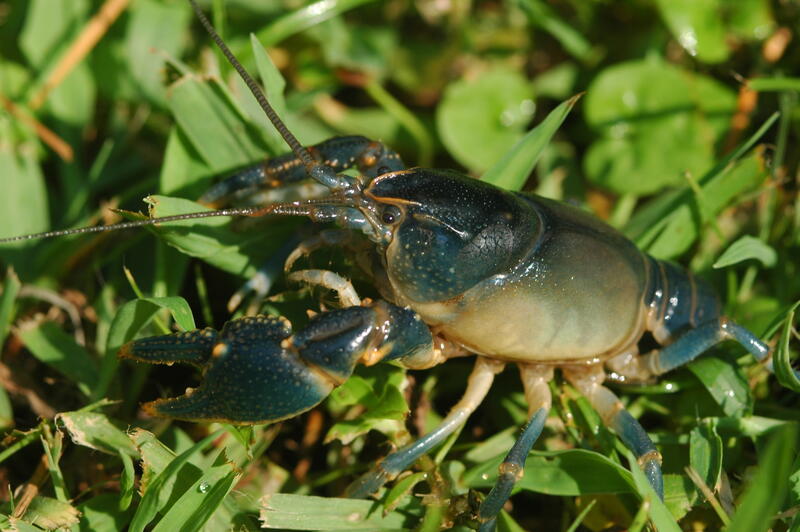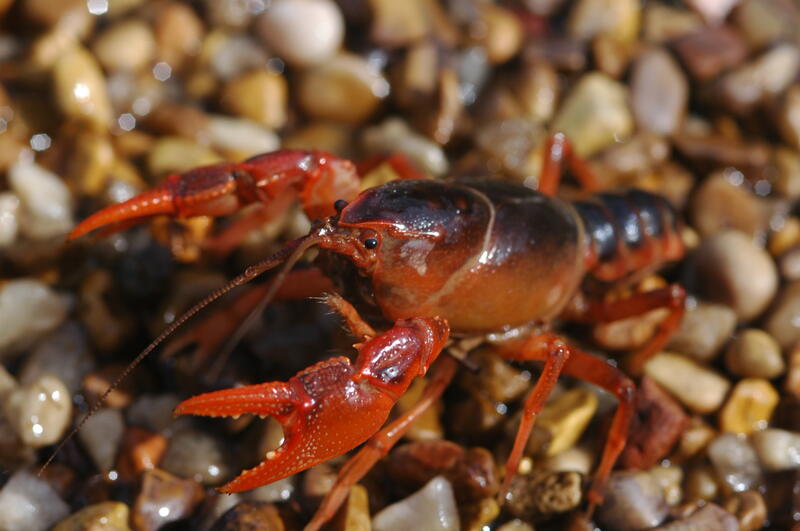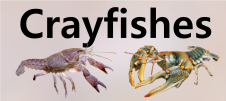





Loading profile. Please wait . . .
Cambarus reflexus Hobbs, 1981
Pine Savannah Crayfish






Federal Protection: No US federal protection
State Protection: No Georgia state protection
Global Rank: G4
State Rank: S2
Element Locations Tracked in Biotics: No
SWAP 2015 Species of Greatest Conservation Need (SGCN): No
SWAP 2025 Species of Greatest Conservation Need (SGCN): No
2025 SGCN Priority Tier: None
Element Occurrences (EOs) in Georgia: 5
Habitat Summary for element in Georgia: Complex burrows in seepage areas and swampy or low lying boggy areas
The overall color of the Pine Savannah Crayfish is reddish-brown to orangish with darker pigment on the cephalic section of the cephalothorax; occasionally the entire dorsal surface is blackish. The tubercles on the claws are brighter orange as are the margins of the rostrum. In two populations in the Savannah River drainage, this species is entirely aqua-bluish except for the claw tubercles which are a cream color. The areola is virtually non-existent on this species and the rostrum is short and broad without marginal spines or tubercles. The abdomen is obviously narrower than the cephalothorax and the claws may be robust. There are two rows of tubercles along the mesial margin of the palm. This species reaches a maximum total body length of about 75 mm (3 in).
No other crayfishes within the range of this species have similar color patterns.
Complex burrows adjacent to streams or in low areas where the water table is near the surface of the ground.
No studies of the Pine Savannah Crayfish are known and the diet of burrowing crayfishes in general is poorly understood. Crayfishes are considered opportunistic omnivores and likely feed on a variety of items, both plant and animal, living or dead. Burrowing crayfishes may forage around the mouths of their burrows, eat organisms that crawl or fall into the burrow, or eat worms that inadvertently tunnel through a burrow wall.
Burrowing crayfishes inhabit a system of tunnels that may be very complex with several openings to the surface. Openings to the tunnels are often marked by piles of dirt or mud pellets (chimneys). Depending on the soil type and moisture content, these chimneys can reach heights of 15 cm (6 inches) or more. These crayfishes are typically confined to their burrows, but a male must leave its burrow to search for females during the reproductive season. As mentioned above, they may also forage near the opening of their burrow. Active burrows with fresh soil are seen from late spring to late fall, particularly after rain events. During the dry part of the summer, burrow openings may be plugged to help conserve moisture in the burrow. Reproduction probably occurs during the spring and fall, but males in reproductive condition may be found at any time during the year. It is very rare to find more than one adult crayfish in the same burrow. When a female crayfish releases her eggs, she attaches them to her swimmerets and is said to be “in berry.” Upon hatching, the juvenile crayfish are attached to the mother by a thread. After the juveniles molt for the second time, they are free of the mother, but stay close and will hold on to her for some time. Multiple juveniles are occasionally found in a single burrow. Eventually they move off on their own. Crayfishes molt 6 or 7 times during their first year of life and most are probably able to reproduce by the end of that year. They molt once or twice a year for the remainder of their lives. Although it is difficult to study burrowing crayfishes, some researchers believe they may live as long as 10 years. Males in reproductive condition have been collected in April, August, and September and two females with eggs were found in April. A female carrying young was collected in August. The smallest reproductive male is about 66 mm (2.6 in) and the smallest female with eggs is about 73 mm (3.1 in) in length (Hobbs 1981).
Burrowing crayfishes may be collected by direct excavation of their burrows, by trapping, and during night surveys. Excavating burrows is time consuming and can be very difficult. It also results in destruction of the animals’ burrow. Traps made with PVC pipes or mist nets can be effective. Burrowing crayfishes are sometimes captured around the openings of their burrows on damp nights. Active burrows are found from about mid-March to mid-November if the water table is within about two feet of the surface of the ground.
The Pine Savannah Crayfish is currently known from the Ogeechee River system in Georgia to the PeeDee drainage in South Carolina. In Georgia it has been found in about 10 locations in the Ogeechee and Savannah river basins.
Activities that destroy burrows or alter hydrology in the vicinity of burrows threaten this and other burrowing species.
Although the species is known from only a few locations, there is limited growth in this region of the state, and it is therefore considered stable.
If possible, areas with burrows should be protected from land disturbing activities. Additional surveys and life history studies are needed to better define the range of the Pine Savannah Crayfish and help predict its response to environmental change. Environmental education programs should include information about burrowing crayfishes and encourage protection of burrows.
Eversole, A.G. and D.R. Jones. 2004. Key to the Crayfish of South Carolina. US Forest Service Publication. 79 pp.
Hobbs, H.H., Jr. 1981. The crayfishes of Georgia. Smithsonian Contributions to Zoology 318:1–549.
Taylor, C.A., G.A. Schuster, J.E. Cooper, R.J. DiStefano, A.G. Eversole, P. Hamr, H.H. Hobbs III, H.W. Robison, C.E. Skelton, and R.F. Thoma. 2007. A reassessment of the conservation status of crayfishes of the United States and Canada after 10+ years of increased awareness. Fisheries 32:372–389.
Christopher E. Skelton
C. Skelton, 2012: original account
C. Skelton, February 2019: general update of account.